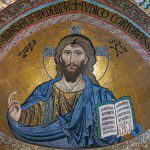This post originally appeared on my old blog in January of 2015. My precise understanding of scripture has continued to evolve since then, and I’d phrase a few things differently today. But I still agree with the substance of what I wrote, so I’m leaving the text unedited.

There once was an invisible man. Though no one could see this man, they could see his shadow. Over the years, people tried to learn about the man by observing his shadow. They recorded their findings, carefully documenting every detail they saw in the shadow.
But they ran into some problems.
For one thing, the shadow didn’t always look the same to everyone. It would acquire the color and texture of whatever it happened to be resting on. And it seemed to change shape depending on the time of day and the angle from which people observed it. Some saw the shadow as extraordinarily tall and skinny, while others saw it as short and squat.
Furthermore, people couldn’t always tell what the man behind the shadow was doing. Wherever the shadow went, things seemed to happen. Strange and mysterious things. Horrible and wonderful things. But because the observers could not determine the man’s actions from the shadow, they tended to assume that he had caused all of these things.
Through it all, the observers documented the shadow, just as each of them saw it. And they documented the things that happened when the shadow was nearby. Though their descriptions sometimes differed, they all accurately described what they had seen in the shadow.
Then one day, the man became visible. He appeared to the people and walked their streets in full sight. Now they could see who he really was. Much of what they had seen in the shadow was true of the man. Yet, understandably, much was also different.
Some of his observers rejoiced to see the man clearly. With their new knowledge about the man, they went back through their documentation, and they finally understood what he had been doing all along. Furthermore, they documented the man himself so that those who had not seen him in person could know what he was really like.
But others had made a critical mistake. They forgot that they were looking at a shadow. They came to believe that the shadow itself was the full revelation of the man. And so, when the man appeared, they rejected him. “This man looks nothing like our shadow,” they said. “After all, we can still see the shadow right there on the ground.”
They could not understand that the shadow merely pointed to the man.
Much time has passed since the man appeared. Today, he is not visible in the way he once was. But his observers left us with two distinct records. The first describes his shadow. And the second describes the man himself. Both records provide accurate descriptions, but they must be properly understood.
Some interpreters of these records still cling to the shadow, and thus they reject the man. Others accept the man, but only in as much as he looks like his shadow. They are happy that he became visible, but they still believe that the shadow was a better representation of him. So they reinterpret the man to make him match his shadow.
But the shadow has only ever pointed to the man. The man himself is the only perfect revelation. And we must interpret the shadow in his light.
“You study the Scriptures diligently because you think that in them you have eternal life. These are the very Scriptures that testify about me, yet you refuse to come to me to have life.” —Jesus (John 5:39–40, NIV)
In the past God spoke to our ancestors through the prophets at many times and in various ways, but in these last days he has spoken to us by his Son, whom he appointed heir of all things, and through whom also he made the universe. The Son is the radiance of God’s glory and the exact representation of his being, sustaining all things by his powerful word. … (Hebrews 1:1–3, NIV)
The law is only a shadow of the good things that are coming—not the realities themselves. … (Hebrews 10:1, NIV)
For the law was given through Moses; grace and truth came through Jesus Christ. No one has ever seen God, but the one and only Son, who is himself God and is in closest relationship with the Father, has made him known. (John 1:17–18, NIV)
The Son is the image of the invisible God, the firstborn over all creation. For in him all things were created: things in heaven and on earth, visible and invisible, whether thrones or powers or rulers or authorities; all things have been created through him and for him. He is before all things, and in him all things hold together. (Colossians 1:15–17, NIV)












